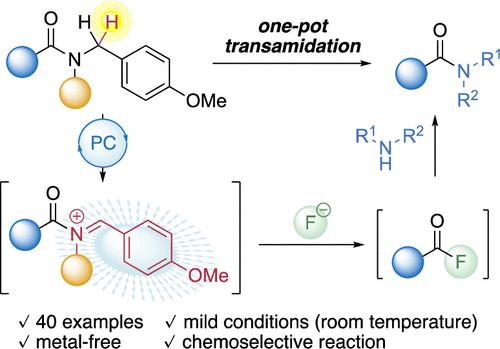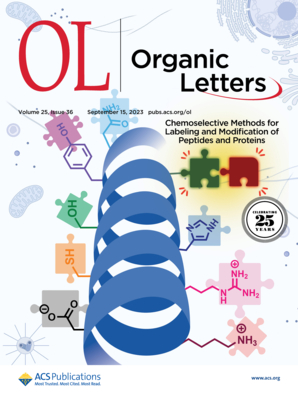无金属光氧化催化下对甲氧基苄基叔酰胺的化学选择性裂解和反式酰胺化反应
IF 5
1区 化学
Q1 CHEMISTRY, ORGANIC
引用次数: 0
摘要
利用 Mes-Acr-Ph+BF4- 和 Selectfluor 激活 PMB 分子中电子丰富的苄基 C-H 键,开发了一种在光氧化条件下无金属、温和地裂解对甲氧基苄基叔酰胺(PMB 叔酰胺)的方法。由此产生的酰基氟化物中间体用途广泛,可促进 PMB 叔酰胺的单锅反酰胺化反应。通过在含有比酰胺更多活性官能团的双官能团分子中对 PMB 叔酰胺进行化学选择性活化,凸显了该方案的价值。本文章由计算机程序翻译,如有差异,请以英文原文为准。

Chemoselective Cleavage and Transamidation of Tertiary p-Methoxybenzyl Amides under Metal-Free Photoredox Catalysis
A metal-free and mild cleavage of tertiary p-methoxybenzyl amides (PMB tert-amide) under photoredox conditions is developed using Mes-Acr-Ph+BF4– and Selectfluor to activate the electron-rich benzylic C–H bond of the PMB moiety. The resulting acyl fluoride intermediate is versatile and facilitates a one-pot transamidation of the PMB tert-amide. The value of this protocol is highlighted by performing the chemoselective activation of the PMB tert-amide in bifunctional molecules containing more reactive functionalities than the amide.
求助全文
通过发布文献求助,成功后即可免费获取论文全文。
去求助
来源期刊

Organic Letters
化学-有机化学
CiteScore
9.30
自引率
11.50%
发文量
1607
审稿时长
1.5 months
期刊介绍:
Organic Letters invites original reports of fundamental research in all branches of the theory and practice of organic, physical organic, organometallic,medicinal, and bioorganic chemistry. Organic Letters provides rapid disclosure of the key elements of significant studies that are of interest to a large portion of the organic community. In selecting manuscripts for publication, the Editors place emphasis on the originality, quality and wide interest of the work. Authors should provide enough background information to place the new disclosure in context and to justify the rapid publication format. Back-to-back Letters will be considered. Full details should be reserved for an Article, which should appear in due course.
 求助内容:
求助内容: 应助结果提醒方式:
应助结果提醒方式:


